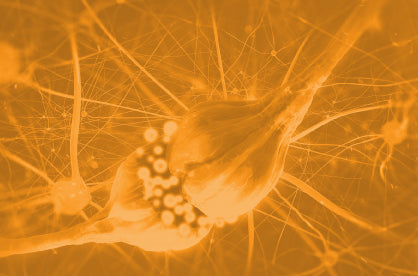
The whole world is getting more anxious by the day. According to recent statistics, up to 33.7% of people will be affected by an anxiety disorder during their lifetime [2], and there are currently 264 million people impacted globally [3].
In 2019, the percentage of patients taking anxiety medication was around 10% in females over 45, and around 5% in males, according to Statista.com. And since the pandemic, these rates have skyrocketed. Currently, 50 million Americans are taking mental health medications. This was an increase of 20% in just one year, from 2020 to 2021, according to the CDC.
In today’s article, we will take a look at the different neurotransmitters involved in the anxiety response and find out what neurotransmitters are most responsible for anxiety.
But first…
What is anxiety?
Anxiety is a powerful and frequent negative emotional state that is most often associated with feelings of worry and apprehension [1]. It is closely related to fear, which is our usual response to perceived or real threats – the "fight or flight" response – but involves some expectation of future harm or insult.
Anxiety is a very normal human emotional response, yet it can become excessive or chronic under certain conditions and wreak havoc on your physiology. Evidence from neuroscience seems to suggest that these anxiety disorders arise from a dysfunction in the brain circuits responsible for how we emotionally respond to threatening situations [1].
Definition: Anxiety is an emotion characterized by persistent, excessive worry often accompanied by physical symptoms such as increased heart rate, tension, and sweat, triggered by anticipation of future events or uncertainty. It represents the brain's primal response to stress.
Consequences of chronic anxiety
When chronic, anxiety can cause a range of biological and psychosocial issues, mostly likely due to chronic sympathetic activation. For example, the presence of mood and anxiety disorders such as post-traumatic stress disorder, panic disorder, and/or social phobia can reduce health-related quality of life and result in more sick days from work [4].
Anxiety can result in problems with family relationships and impaired physical and cognitive functioning. In adolescents, anxiety seems to worsen these psychosocial outcomes by the age of 30 [5].
So, what neurotransmitters are involved?
GABA and anxiety
In both normal and disordered anxiety, the inhibitory neurotransmitter GABA (γ-aminobutyric acid) plays a key role in the anxiety response, especially in the brain circuits of the amygdala [1]. The amygdala is a region of the brain that forms the core of a processing network that deals with fearful and threatening stimuli and activates fear-related behavior [2]. It is located in the medial temporal lobe, just anterior to (in front of) the hippocampus.
Research in several animal species has shown that when GABA is infused into the amygdala, measures of fear and anxiety decrease. Conversely, when GABA antagonists are infused, it brings about the opposite effect [1,3].
GABA has been associated with anxiety for a long time, and the drugs used to target disordered anxiety, such as benzodiazepines, are geared towards this neurotransmitter system [1]. Human studies show that when benzodiazepines are provided, the activation of the amygdala in the presence of negative emotional stimuli is reduced [4]. Some supplements directly increase the amount of GABA in the human brain or increase GABA activity… but be careful, as oral GABA does not cross the blood-brain barrier.
Serotonin and anxiety
Serotonin, or 5-hydroxytryptamine (5-HT), plays an essential role in the regulation of our emotions.
It is involved in a wide range of neurological activities and modulates virtually all human behavioral processes, to the degree that drugs targeting serotonin receptors are used extensively in the psychiatry and neurology disciplines [5]. It is the use of these drugs that has revealed a key role for this neurotransmitter in anxiety settings [6].
Research in mice shows that serotonin from the dorsal raphe nucleus (located on the midline of the brain stem) enhances fear and anxiety [7]. This at least partly explains why early adverse events may occur when selective serotonin reuptake inhibitors (SSRIs) – drugs that block the reuptake of serotonin into the synapse – are provided to some patients with anxiety disorders. Reduced serotonin transporter availability in the thalamus is associated with high anxiety in a study of patients with major depression [8], further underlining the importance of this neurotransmitter, although there is now recent evidence that serotonin is not depleted in most patients with depression.
Dopamine and anxiety
Alongside the amygdala, baseline and stress-induced anxiety states are also governed by other brain regions, such as the prefrontal cortex and hippocampus [9]. Each of these regions is influenced by signals from dopamine-rich areas of the midbrain that help shape anxiety-like behavior [10].
Dopamine is a neurotransmitter that plays a central role in reward behavior, sleep, mood, attention, learning, and pain processing, to name a few [11]. In the ventral midbrain, dopamine neurons innervate several limbic structures that are implicated in how we process emotions [12].
Some evidence has revealed that the mesolimbic, mesocortical, and nigrostriatal dopaminergic systems are all involved in anxiety, and underpinned by dopamine D1 and D2 receptor mechanisms [13]. The activity of the dopaminergic system is also influenced by other neurotransmitters discussed in this article (notably GABA) in the medial prefrontal cortex and nucleus accumbens, respectively.
The evidence seems to suggest that for social anxiety in particular, dopaminergic brain circuitry might underpin these often challenging anxiety symptoms [14].
Norepinephrine and anxiety
Norepinephrine, also known as noradrenaline, is a neurotransmitter and hormone involved in the "fight or flight" response (i.e., oh sh*t, there's a bear!). It modulates the activity of brain regions relevant to anxiety, such as the amygdala, and anxiety states are associated with the release of norepinephrine into the bloodstream and cerebrospinal fluid [15].
From a functional standpoint, norepinephrine is involved in a range of processes, including arousal, cognition, learning, and sleep regulation, as well as the regulation of the stress response [16].
Given the relationship between the serotonin and noradrenaline systems, so-called "dual-reuptake inhibitors" such as venlafaxine, milnacipran, and duloxetine were developed and may have an advantage over SSRIs in the treatment of anxiety and certain related disorders, such as post-traumatic stress disorder [15].
Is anxiety good for the brain?
There is no doubt that some anxiety can improve motivation, focus, and even heighten senses. These benefits are directly related to the neurotransmitters above, especially dopamine and norepinephrine. But when anxiety becomes constant in the form of chronic anxiety and these neurotransmitters are continuously released, these same neurotransmitters can lead to pathology that runs the gamut from mental disorders (anxiety, obviously, but also depression, violence, and more) to heart attacks, hypertension, strokes, and other physical ailments. So, too much of a helpful thing isn’t so helpful after all. Just like bananas. Or Christmas.
Decrease anxiety with Tro Calm
At Troscriptions, we developed Tro Calm for those of us (i.e., all of us) who have times of stress and anxiousness where calming down on demand is vital. It is formulated with N-nicotinoyl-GABA and kava that both enhance the GABA system as well as cannabidiol and cannabigerol which modulate the endocannabinoid system to calm you down too. Like all of our buccal troches, it is titratable so you can find your optimal dose. On average, ¼ troche will take the edge off without letting you lose your focus or concentration (i.e., perform better when you’re less anxious), ½ troche will relax you and you’ll be less focused, and ¾ to 1 full troche will give you deeper relaxation and deeper sleep. Decrease your anxiousness with Tro Calm now and discover the calm way to control your emotions.
FAQ
-
What causes anxiety in the brain?
Anxiety in the brain is typically caused by a combination of genetic factors, environmental triggers, and chemical imbalances. These can lead to an overactive fear response, which is characteristic of anxiety disorders. Treatment of anxiety disorders and the symptoms of anxiety often involves addressing these underlying causes.
-
What is the 3-3-3 rule for anxiety?
The 3-3-3 rule is a coping strategy for depression and anxiety. It involves identifying three things you see, three sounds you hear, and moving three parts of your body. This grounding exercise is designed to help bring your focus back to the present moment, reducing anxiety symptoms and managing mood disorders.
References
[1] P. Nuss, Anxiety disorders and GABA neurotransmission: a disturbance of modulation, Neuropsychiatr Dis Treat. 11 (2015) 165–175. https://doi.org/10.2147/NDT.S58841.
[2] M.G. Baxter, P.L. Croxson, Facing the role of the amygdala in emotional information processing, Proc. Natl. Acad. Sci. U.S.A. 109 (2012) 21180–21181. https://doi.org/10.1073/pnas.1219167110.
[3] C.A. Barbalho, R.L. Nunes-de-Souza, A. Canto-de-Souza, Similar anxiolytic-like effects following intra-amygdala infusions of benzodiazepine receptor agonist and antagonist: Evidence for the release of an endogenous benzodiazepine inverse agonist in mice exposed to elevated plus-maze test, Brain Research. 1267 (2009) 65–76. https://doi.org/10.1016/j.brainres.2009.02.042.
[4] M.P. Paulus, J.S. Feinstein, G. Castillo, A.N. Simmons, M.B. Stein, Dose-Dependent Decrease of Activation in Bilateral Amygdala and Insula by Lorazepam During Emotion Processing, Arch Gen Psychiatry. 62 (2005) 282. https://doi.org/10.1001/archpsyc.62.3.282.
[5] M. Berger, J.A. Gray, B.L. Roth, The Expanded Biology of Serotonin, Annu. Rev. Med. 60 (2009) 355–366. https://doi.org/10.1146/annurev.med.60.042307.110802.
[6] J.A. Gordon, R. Hen, The Serotonergic System and Anxiety, NMM. 5 (2004) 027–040. https://doi.org/10.1385/NMM:5:1:027.
[7] C.A. Marcinkiewcz, C.M. Mazzone, G. D’Agostino, L.R. Halladay, J.A. Hardaway, J.F. DiBerto, M. Navarro, N. Burnham, C. Cristiano, C.E. Dorrier, G.J. Tipton, C. Ramakrishnan, T. Kozicz, K. Deisseroth, T.E. Thiele, Z.A. McElligott, A. Holmes, L.K. Heisler, T.L. Kash, Serotonin engages an anxiety and fear-promoting circuit in the extended amygdala, Nature. 537 (2016) 97–101. https://doi.org/10.1038/nature19318.
[8] M. Reimold, A. Batra, A. Knobel, M.N. Smolka, A. Zimmer, K. Mann, C. Solbach, G. Reischl, F. Schwärzler, G. Gründer, H.-J. Machulla, R. Bares, A. Heinz, Anxiety is associated with reduced central serotonin transporter availability in unmedicated patients with unipolar major depression: a [11C]DASB PET study, Mol Psychiatry. 13 (2008) 606–613, 557. https://doi.org/10.1038/sj.mp.4002149.
[9] G.G. Calhoon, K.M. Tye, Resolving the neural circuits of anxiety, Nat Neurosci. 18 (2015) 1394–1404. https://doi.org/10.1038/nn.4101.
[10] S.R. DeGroot, R. Zhao-Shea, L. Chung, P.M. Klenowski, F. Sun, S. Molas, P.D. Gardner, Y. Li, A.R. Tapper, Midbrain Dopamine Controls Anxiety-like Behavior by Engaging Unique Interpeduncular Nucleus Microcircuitry, Biological Psychiatry. 88 (2020) 855–866. https://doi.org/10.1016/j.biopsych.2020.06.018.
[11] G. Ayano, Dopamine: Receptors, Functions, Synthesis, Pathways, Locations and Mental Disorders: Review of Literatures, J Ment Disord Treat. 2 (2016). https://doi.org/10.4172/2471-271X.1000120.
[12] L.S. Zweifel, J.P. Fadok, E. Argilli, M.G. Garelick, G.L. Jones, T.M.K. Dickerson, J.M. Allen, S.J.Y. Mizumori, A. Bonci, R.D. Palmiter, Activation of dopamine neurons is critical for aversive conditioning and prevention of generalized anxiety, Nat Neurosci. 14 (2011) 620–626. https://doi.org/10.1038/nn.2808.
[13] M.-R. Zarrindast, F. Khakpai, The Modulatory Role of Dopamine in Anxiety-like Behavior, Arch Iran Med. 18 (2015) 591–603.
[14] T. Lawn, O. Dipasquale, A. Vamvakas, I. Tsougos, M.A. Mehta, M.A. Howard, Differential contributions of serotonergic and dopaminergic functional connectivity to the phenomenology of LSD, Psychopharmacology (Berl). (2022). https://doi.org/10.1007/s00213-022-06117-5.
[15] D.S. Baldwin, Serotonin noradrenaline reuptake inhibitors: A new generation of treatment for anxiety disorders, International Journal of Psychiatry in Clinical Practice. 10 (2006) 12–15. https://doi.org/10.1080/13651500600637056.
[16] N. Brunello, P. Blier, L.L. Judd, J. Mendlewicz, C.J. Nelson, D. Souery, J. Zohar, G. Racagni, Noradrenaline in mood and anxiety disorders: basic and clinical studies:, International Clinical Psychopharmacology. 18 (2003) 191–202. https://doi.org/10.1097/00004850-200307000-00001.





Comments (0)
There are no comments for this article. Be the first one to leave a message!